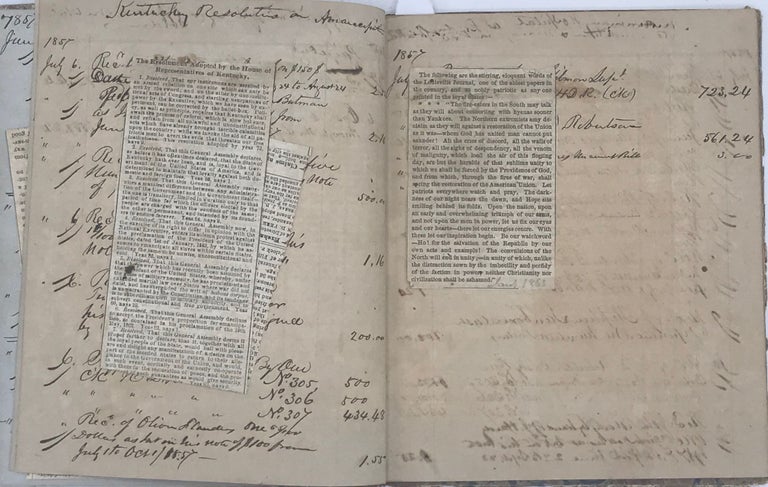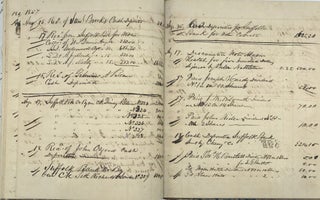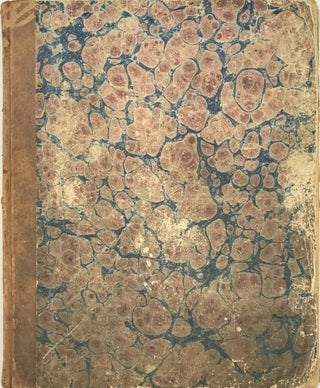RECORDS OF TRANSACTIONS FOR A MEMBER OF THE SUFFOLK BANKING SYSTEM OF NEW ENGLAND, 1857 - 1858, LIKELY THE WARNER BANK OF NEW HAMPSHIRE.
[Warner, NH?]. Manuscript ledger for a bank belonging to the Suffolk Banking System, June 29, 1857 - Feb. 20, 1858, most probably the Warner Bank of Warner, New Hampshire. Contemporary leather backed marbled boards. 20 cm. 126 pp., near daily entries, with multiple items per page, in a legible hand. Entries are listed by date, giving the customer's name, and a record of the note they were paying against, or the amount being deposited, or the dividend on shares of stock paid out, etc. Some receipts for loan amounts are given in full, some are recorded as "discount notes." At some later date a handful of newspaper articles from the 1860s, reporting on the Civil War, were tipped in to the first nine pages of the daybook, partly obscuring a few entries.
Bank transactions with numerous individuals and businesses are recorded. Companies include Southard Herbert & Co., Cheney & Co., Smith & Wallace, Johnson Sewall & Co., Hallett Pinkham & Quimby Co., Greenwood & Burpee, etc. The bank did repeat business with Walter Harriman, H.D. Robertson, E.G. Currier, Doct. J.H. Ames, among many others, and a handful of women including Elizabeth Smith, Charlott[e?] Badger, Betsy Crissy [sp?], and Sophia Bartlett. From Joseph A. Gilman the bank recorded receipt of $10,000 for a Concord RR note. A "discounted note Leonard Eaton for two hundred dollars," $500 Northern R. Bonds pledged as collateral, is recorded on Dec. 1, 1857. On Oct. 16, 1857, $100 was paid out to George Jones, Cashier. Funds were paid out to Doctor [J.H.] Ames Dividend No. 13 on 25 shares on Aug. 3, 1857. Joseph Hardy and John Brown were each paid Dividend No. 14 for shares of stock on Feb. 2, 1858. Several smaller expenditures are recorded including paying a washerwoman to clean the bank rooms; the purchase of postage stamps and payment for a post office box; and 13 cents for a Bank note detector. On Feb. 8 the bank paid out $3 for a counterfeit bill Doct. Ames received from the Andover Bank of Massachusetts. Item #67562
The Suffolk banking system of New England was run by the Suffolk Bank of Boston from 1824 to 1858. "Before the rise of the system, Boston and its environs had suffered from the same monetary confusion as the rest of our Union. Numerous state-chartered banks issued paper bank notes in profusion, with common criminals and (in some cases) the issuing banks themselves counterfeiting freely. For a merchant in Boston and for any city banker who accepted the notes of distant country banks, the risk that a note might not be worth the paper it was printed on was ever present. The relatively poor quality of the country-bank-issued versus the city-bank-issued bank notes triggered Gresham's law — bad money drove out the good." [see: "Life without the Fed: The Suffolk System," by C.J. Malone, 2011.]
To combat this problem a consortium of seven Boston banks formed the Suffolk banking system, and they invited every city and country bank within the New England area to join. Operations commenced on March 24, 1824, with every member bank required to maintain a permanent, non–interest bearing account at Suffolk, along with an additional account with enough of a balance to clear all paper bank notes presented for redemption. Eventually the notes of member banks would be cleared against each other, and loans would be granted for "overdrafts." The system accepted paper notes from all member banks of good standing at par. All paper notes of nonmember banks were immediately sent back to the issuer for redemption in gold. The Suffolk Bank itself, upon taking responsibility for the entire system in 1825, rose to become the most profitable bank in Boston. It did not have a competitor in the field until 1858. [see "Lessons from a Laissez-Faire Payment System: The Suffolk Banking System (1825-1858), by Arthur Rolnick, Bruce Smith, & Warren Weber, for an historic overview, published in the Federal Reserve Bank of Minneapolis Quarterly Review, Summer 1998]
By 1857, the consortium had expanded to include banks in Maine, New Hampshire and Vermont, as well as Massachusetts. A careful reading of this ledger seems to indicate that it was from the Warner Bank in Warner, New Hampshire. Chartered by the town in 1850, with capital of $50,000 its Presidents included Joshua George, Dr. Jason H. Ames, Franklin Simonds, and N.G. Ordway, with cashiers Francis Wilkins and George Jones. As noted, several of these names appear in the ledger. One of the many customers mentioned here included Harrison D. Robertson (1806-1862) who engaged in the mercantile business and coopering, was postmaster of the town for 14 years, and a representative for 4 years. He was also one of the incorporators of the Concord & Claremont Railroad in 1848. [see: "The History of Warner, New Hampshire..." by Walter Harriman (Concord, NH: 1879)].
Price: $600.00



